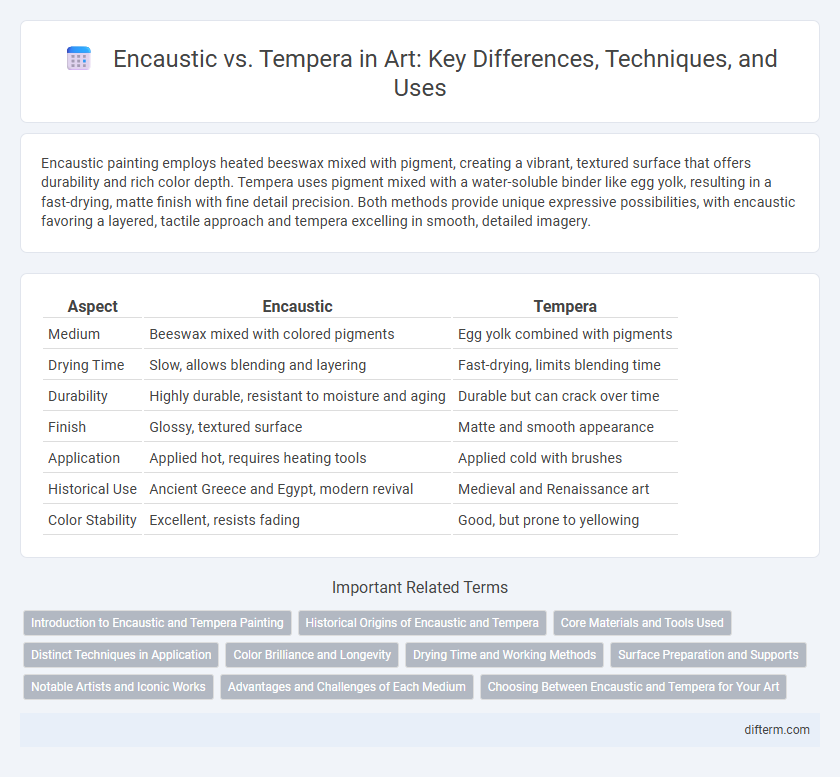Encaustic painting employs heated beeswax mixed with pigment, creating a vibrant, textured surface that offers durability and rich color depth. Tempera uses pigment mixed with a water-soluble binder like egg yolk, resulting in a fast-drying, matte finish with fine detail precision. Both methods provide unique expressive possibilities, with encaustic favoring a layered, tactile approach and tempera excelling in smooth, detailed imagery.
Table of Comparison
| Aspect | Encaustic | Tempera |
|---|---|---|
| Medium | Beeswax mixed with colored pigments | Egg yolk combined with pigments |
| Drying Time | Slow, allows blending and layering | Fast-drying, limits blending time |
| Durability | Highly durable, resistant to moisture and aging | Durable but can crack over time |
| Finish | Glossy, textured surface | Matte and smooth appearance |
| Application | Applied hot, requires heating tools | Applied cold with brushes |
| Historical Use | Ancient Greece and Egypt, modern revival | Medieval and Renaissance art |
| Color Stability | Excellent, resists fading | Good, but prone to yellowing |
Introduction to Encaustic and Tempera Painting
Encaustic painting involves using heated beeswax mixed with colored pigments, applied in molten form to create rich, textured surfaces known for their durability and luminous depth. Tempera painting, traditionally made by blending egg yolk with pigment, dries quickly to form a matte finish and is valued for its precision and fine detail in early Renaissance artworks. Both techniques offer distinct visual qualities and historical significance, with encaustic favored for layering effects and tempera for its crisp, lasting lines.
Historical Origins of Encaustic and Tempera
Encaustic painting originated in ancient Greece around the 5th century BCE, utilizing heated beeswax mixed with colored pigments for its distinctive luminous finish. Tempera, commonly attributed to ancient Egyptian and medieval European art, employs a water-based egg yolk binder that produces a fast-drying, matte surface. Both techniques reflect rich historical traditions, with encaustic valued for durability and tempera for precise detail in panel paintings.
Core Materials and Tools Used
Encaustic painting relies on heated beeswax mixed with colored pigments, applied with brushes or heated metal tools that allow precise manipulation of wax layers. Tempera uses egg yolk as a binder combined with powdered pigments, applied with fine brushes on a rigid surface like wood panels or gessoed boards for a matte finish. The fundamental difference lies in encaustic's use of wax and heat versus tempera's water-based, egg yolk medium, influencing texture, durability, and application methods.
Distinct Techniques in Application
Encaustic painting uses heated beeswax mixed with colored pigments, applied in layers with tools or brushes while molten, allowing for rich texture and a luminous surface. Tempera employs pigment mixed with a water-soluble binder, typically egg yolk, applied in thin, precise brushstrokes that dry quickly to a matte finish. The distinct handling properties of encaustic's molten medium versus tempera's fast-drying emulsion result in contrasting visual effects and durability in artwork.
Color Brilliance and Longevity
Encaustic painting, utilizing heated beeswax mixed with pigments, offers unmatched color brilliance due to its translucent layers that enhance depth and luminosity. Tempera, made from pigment and egg yolk, provides a matte finish with stable, fast-drying colors but less vibrancy compared to encaustic. In terms of longevity, encaustic paintings boast exceptional durability resistant to moisture and aging, while tempera artworks can be more prone to cracking and fading over time.
Drying Time and Working Methods
Encaustic paint, made from heated beeswax and pigment, has a slow drying time, allowing artists extended periods to manipulate textures and details while working. Tempera, composed of pigment mixed with egg yolk, dries rapidly to a matte finish, requiring precise, swift brushwork and layering techniques to build depth. The contrasting drying times between encaustic and tempera significantly influence the rhythm and style of artistic creation.
Surface Preparation and Supports
Encaustic painting requires a rigid, non-porous support such as wood panels treated with a sealant to prevent wax absorption, ensuring proper adhesion and durability. Tempera favors rigid surfaces like wood panels or gesso-primed boards, where a smooth, absorbent ground allows fine detailing and color luminosity. Both techniques demand meticulous surface preparation, with encaustic prioritizing heat-resistant stability and tempera emphasizing a smooth, absorbent base for pigment adherence.
Notable Artists and Iconic Works
Jasper Johns is a key figure in encaustic painting, renowned for his use of wax-based media in works like "Flag" (1954-55), which showcases the texture and depth achievable with encaustic techniques. Tempera, celebrated for its fast-drying and vibrant qualities, was famously employed by Sandro Botticelli in "The Birth of Venus" and by Giotto di Bondone in the frescoes of the Scrovegni Chapel, exemplifying its historical significance in early Renaissance art. These distinct mediums highlight the evolution of artistic expression through their association with iconic creators and masterpieces.
Advantages and Challenges of Each Medium
Encaustic painting offers vibrant color retention and durability due to its wax-based medium, allowing for rich texture and layering, but requires heat and specialized tools, which can pose challenges for beginners. Tempera, made from pigment and egg yolk, is valued for its quick drying time and fine detail precision, yet its fragility and susceptibility to cracking over time require careful handling and support. Both media provide unique aesthetic qualities but demand specific techniques and environments to preserve their longevity.
Choosing Between Encaustic and Tempera for Your Art
Encaustic painting uses heated beeswax mixed with pigments, offering rich texture and durability, while tempera employs egg yolk as a binder, resulting in a matte finish and quick drying time. Artists must consider factors such as desired texture, color vibrancy, longevity, and medium handling when choosing between encaustic and tempera. Practicality for different surfaces and the archival properties of each medium also influence the decision-making process in art creation.
encaustic vs tempera Infographic

 difterm.com
difterm.com